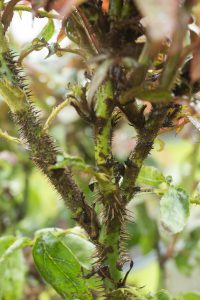I heard about a dangerous rose disease. How would I know if my roses have gotten it?
The worst rose disease is called Rose Rosette Disease, which is a virus that is spread by the eriophyid mite. Though we have plenty of those unusual 4-

legged mites here, the disease doesn’t appear to have reached our area yet. However, it has been spreading down from the north for many years. The good news for us is that, as far as we know, it has currently only been found in areas of North Florida, especially along the western part of the panhandle.
How do these mites spread the disease?
Since the mites do not fly, but crawl, and are carried to new areas by wind, and also by grafting, and by people who move roses from one area to another. Since the mites are microscopic, you will not see them.
How did the disease get here?

In the U.S it all began with the importation of a new multiflora rose from Japan. Others were imported and used as a rootstock for garden roses. These plants were grafted and planted in gardens. Since the multiflora rose is very vigorous, it was also planted for erosion control, used as a barrier along highways, and even used as cattle fencing. Eventually it was decided that the exotic rose was invasive, and most areas declared it to be a weed. Some of the bushes had the imported Rose Rosette Disease, so the disease and our mites were then used as a biological control against the terrible plant. Unfortunately, the mites also spread the disease to all other types of roses in the U.S.
What are the symptoms?
The list includes witches’ broom, excess thorns, permanent reddening of leaves, rapid elongation of new shoots, distorted flower buds, distorted leaf shapes, abnormal flower color, leaf mosaic, uneven thickening of stems, leaves within the flowers, and severe yellowing. Plants die in 1 or 2 years. Removal of infected plants and roots is necessary. Put all parts in the landfills.

What do we do for now?
Good cultural practices are the best defense. Pruning and spraying with horticultural oil can reduce mite populations. However, the current chemical sprays for spider mites do not work on this mite. There is a spray listed (Avid) as killing this mite, but there is danger of resistance, so it should not be used when the disease is not in the area. Picking up dead rose debris can help. Place roses far enough apart to discourage mites from crawling from one plant to another. Besides all of this, it couldn’t hurt to buy roses from trusted local sources.
Need more information:
For more information about Florida Friendly Plants and Wildlife you can email me at epabon5@ufl.edu or like us to learn about new classes or events at Gardening in Central Florida
By: Sandy Switek since 2005 and Eva Maria Pabon Residential Horticulture Agent
Do you want to read more about gardening? Follow our blog Eva Pabon, Author at UF/IFAS Extension Osceola County (ufl.edu)
 2
2

